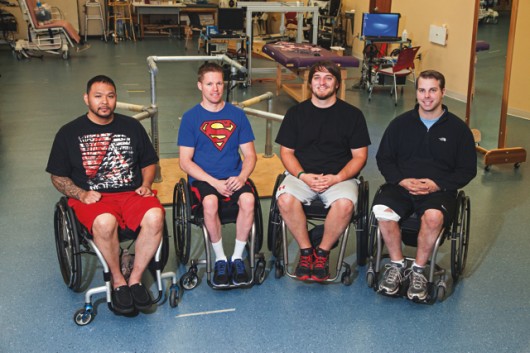In 2011, 25 year-old paraplegic Rob Summers was able to temporarily regain limited use of his legs, thanks to an experimental technique known as epidural electrical stimulation of the spinal cord. Now, in a new study, Summers and three other paraplegic test subjects have shown even more promising results, thanks to the technology.
Epidural electrical stimulation involves implanting an electrode array along the lower part of the spinal cord, which ordinarily controls movement of the hips, knees, ankles and toes. Unlike some similar approaches, the electrodes aren't being used to directly stimulate the muscles. Instead, they act to reengage the spinal cord's local nerve network, which doesn't require input from the brain to carry out basic motor functions. The researchers surmised that this stimulation, combined with sensory input such as stepping on a treadmill could lead to movement.
The latest study was conducted by researchers at the University of Louisville, UCLA and Russia's Pavlov Institute of Physiology. Joining Summer in the tests were epidural stimulator recipients Kent Stephenson, Andrew Meas and Dustin Shillcox. All four had experienced their spinal cord injuries at least two years prior to the study, and two of them were considered to have no chance of recovery.
Test subjects Andrew Meas, Dustin Shillcox, Kent Stephenson and Rob Summers (left to right)
The scientist were surprised to see that immediately after implantation and activation of their stimulators, all three of the newer participants were able to initiate voluntary movement of their hips, ankles and toes. Particularly in the case of the two men with no sensation below the waist, it had been assumed that at least some sort of connection between the brain and the lower spinal cord would be necessary for the system to work.
Additionally, after a period of using the stimulators while performing rehabilitative therapy, the test subjects were able to activate the same movements using less stimulation. This was reportedly an indication of the spinal neural network's ability to learn from repeated stimulation, to the point that it could form pathways of its own.
The test subjects also experienced increased muscle mass, better regulation of blood pressure, a reduction in fatigue, and a much-improved sense of well-being.
"We have uncovered a fundamentally new intervention strategy that can dramatically affect recovery of voluntary movement in individuals with complete paralysis, even years after injury," said the University of Louisville's Prof. Susan Harkema. "The belief that no recovery is possible and complete paralysis is permanent has been challenged."
A paper on the research was recently published in the journal Brain. The test subjects can be seen using their stimulators to move their legs, in the video below.
Sources: UCLA, National Institutes of Health


